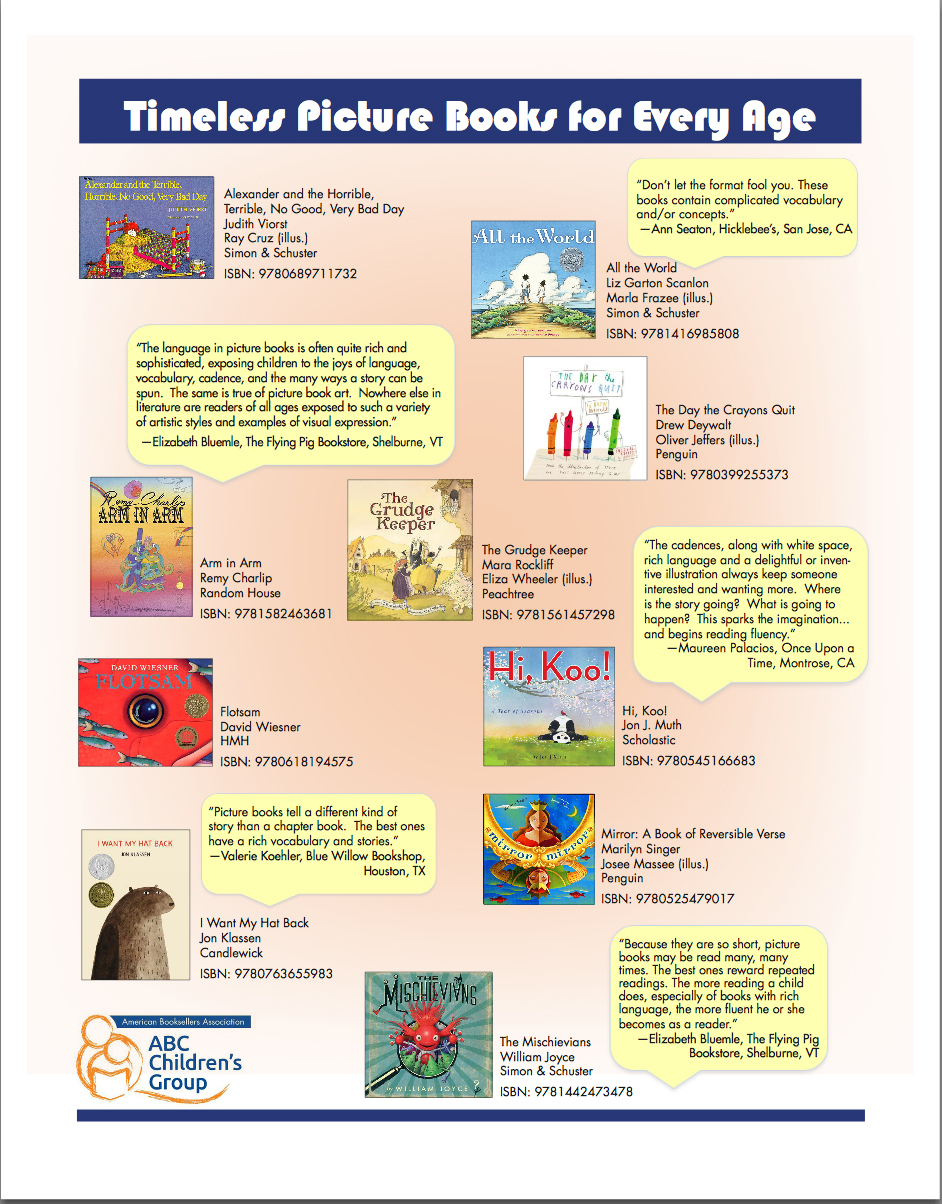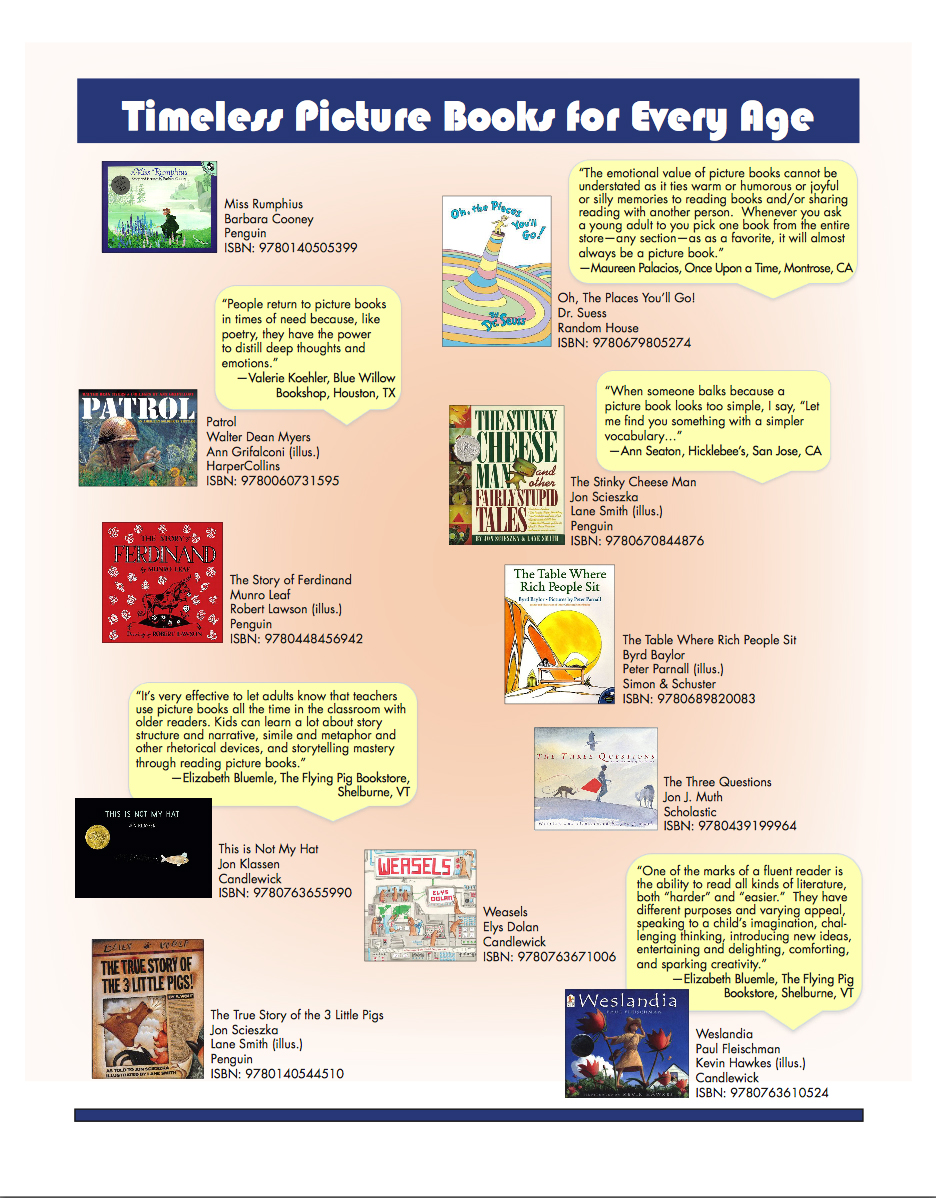 Recently, I wrote a blog post (Are We Rushing Kids Out of Picture Books?) about the way children are pushed toward chapter books at younger and younger ages. The topic struck a nerve; thoughtful comments poured in. Then at the ABC Children’s Institute in San Antonio earlier this month, I was on a panel discussing this topic (Selling Picture Books in the Wake of Age Compression) with several other children’s booksellers and librarians, and the room was overflowing and the conversation energetic. Clearly, this is a subject people feel passionate about!
Recently, I wrote a blog post (Are We Rushing Kids Out of Picture Books?) about the way children are pushed toward chapter books at younger and younger ages. The topic struck a nerve; thoughtful comments poured in. Then at the ABC Children’s Institute in San Antonio earlier this month, I was on a panel discussing this topic (Selling Picture Books in the Wake of Age Compression) with several other children’s booksellers and librarians, and the room was overflowing and the conversation energetic. Clearly, this is a subject people feel passionate about!
The panelists were (including me): Elizabeth Bluemle, Flying Pig Bookstore (Shelburne, VT); Maureen Palacios, Once Upon a Time (Montrose, CA); Ann Seaton, Hicklebee’s (San Jose, CA); Marianne Follis, Ph.D, senior librarian at Valley Ranch Library (Irving, TX); moderated by Valerie Koehler, Blue

Willow Bookshop (Houston, TX).
I thought I would share the terrific list of suggestions made by the panelists and the attendees. Because the discussion was rapid and I was writing by hand, I couldn’t attribute each suggestion to its bookseller, so thank you to all of the fabulous folks who shared their expertise and great ideas!
Also, the ABC made a wonderful poster that bookstores (and schools and libraries) might want to use, as a handout for customers and staff members.
I’ve divided the suggestions into categories: Talking Points, Display Ideas, Staff Training, and Quotables. Please feel free to print out this bulleted list and share it with your bookselling, library, and teaching colleagues if you think it would be helpful.
INDEPENDENT BOOKSELLERS’ TIP SHEET: PICTURE BOOKS ARE FOR ALL AGES
Customer Education and Handselling Tips
The term “picture book” simply refers to a book format in which art and text depend on one another for the full meaning of the book to emerge. Picture books span a wide range of intended ages. There are picture books for babies, picture books for just about every age of childhood, and picture books for adults.
Though they may seem simple, picture books often contain more sophisticated language than chapter books, because they are intended for fluent readers to read aloud, not for beginning readers to sound out. So an adult trying to move a child toward a more challenging read might in fact find that challenge right there in the picture book section.
It’s very effective to let adults know that teachers use picture books with older kids all the time in classroom settings. In addition to sparking various kinds of social studies conversations and explorations of art and the interaction of text and art, picture books can teach kids a lot about story structure, narrative, rhetorical devices, voice, and storytelling mastery.
Wow them with science: A child development expert friend of mine said that picture books connect our visual and auditory cortex with our frontal lobe in a way that even illustrated chapter books don’t. For example, the illustrations in a picture book often introduce an unwritten subplot, tell mini-stories not in the text, or actually contradict the text — inviting the brain to make connections in a way that chapter books generally don’t.
Picture books are excellent for social-emotional development. A picture book can be the fastest way to spark a conversation or get to the meat of a topic with older kids.
Relatability is crucial; often children are rushed away from books that are developmentally appropriate for their abilities and interests, and into books they won’t get nearly as much out of. (One bookseller asks children who pick chapter books that are meant for older kids to promise to re-read the book when they are older, and some kids have come back and said, “It’s a totally different book now!”)
A 32-page picture book may cost the same as a 350-page novel, but a picture book is read over and over again, and each time there may be something new to discover. The more reading a children does, especially of books with rich language, the more fluent he or she becomes as a reader.
Don’t give away your child’s board books too soon; they are perfect for when a child becomes a beginning independent reader, and he or she can read those old favorites to littler siblings, to pets or stuffed animals.
The language in picture books is often quite rich and sophisticated, exposing children to the joys of language, vocabulary, cadence, and to the many ways a story can be spun.
The same is true of picture book art. Nowhere else in literature are readers of all ages exposed to such a variety of artistic styles and examples of visual expression.
Wordless picture books: suggest that older siblings ‘read’ wordless picture books to younger siblings.
Author Aaron Becker (Journey; Quest) has written a wonderful guide to ‘reading’ wordless picture books aloud.
One of the marks of a fluent reader is the ability to read all kinds of literature, both “harder” and “easier.” They have different purposes and varied appeal, speaking to a child’s imagination, challenging thinking, introducing new ideas, entertaining and delighting, comforting, and sparking creativity.
How many kids get turned off reading because they’re pushed too fast away from the books they truly love?
Humor trumps all. Find the funny intelligent book, the funny artistic book, the funny musical book, etc., and your customer will be hooked.
A terrific article in the May/June 2011 issue of the Horn Book finds author/artist Marla Frazee and her editor, Allyn Johnston, discussing “Why We’re Still in Love with Picture Books (Even Though They’re Supposed to be Dead.” Also, the Horn Book has many interviews with artists; sharing these with parents can help them better appreciate the treasure trove of visual literacy picture books provide.
Quotables
“A picture book is not an age. It’s a form.”
“It’s never too late for a great picture book.”
Call the longer, older-aimed picture books “picture novellas.”
For adults wanting to steer their children toward a chapter book that is simply too old for their child developmentally: “Just because they CAN read a book doesn’t mean they SHOULD.” (Books resonate with different ages differently.) OR: “They can read it, but they will get so much more out of it when they’re [perfect age for book].”
Again, for adults steering their children away from age- and interest-appropriate picture books: “Relatability is the single biggest factor for a book’s success with a child.”
For younger children wanting to choose a chapter book because it’s thick and looks like what their older siblings/friends are reading: “That’s [chapter book] a good book to carry around, but this [picture book] is a great book to read!”
“We aren’t gatekeepers, but guides.” Our job is to help children find the books they will love deeply, the right books at the right time. (One great strategy a bookseller used for discouraging a too-young kid from reading The Hunger Games was to ask, “Are you into politics?” At six or seven, the answer was a resounding NO. That approach helps place the decision in the child’s hands, with a little help.)
Staff Training (for General Bookstores as well as Children’s-Only)
New staff training — the store tour always ends in the picture book section.
One store has daily story time; new staff (in all sections, not just children’s) must watch every story time for two weeks.
Staffers are encouraged to take a stack of picture books home every single day. You can’t recommend what you haven’t read.
Storytime for staff — take time for some impromptu readings of picture books during the work day.
Staff read picture books out loud occasionally at the front counter; it always sells books.
As you receive new picture books, take time to share them with colleagues.
Everyone on staff must spend a half hour per week in the children’s department.
At staff meetings, have each bookseller bring a favorite picture book to ‘handsell’ to colleagues.
Write reviews from the proofs of picture books pre-publication; that way, the buyer’s enthusiasm for the picture book is fresh. The shelftalker will help familiarize other staff with the books when it eventually comes in.
Display or Event Ideas That Have Worked Well
Staff Picks Comfort Books: Make a display of staff picture-book comfort reads (i.e., picture books read by adults) with shelftalkers from staff members explaining why they love and turn to this book in times of stress or sorrow.
Tie in with current events or culture: When Cosmos aired on PBS, for example, one bookstore did extremely well with a display on space-related picture books. Another store did an entire window display on picture books featuring numbers in some way; this display sold amazingly well.
Great All-Family Read-Aloud Picks: This display highlights picture books that appeal to ALL ages, not just the family’s youngest members.
Some stores arrange picture books by age range: baby books; preschool to kindergarten; elementary age.
Pair a picture book with a novel for children’s in-store book groups.
*************
Please feel free to share some of the tips that work well in your store (or library)!

I agree that children are steered away from picture books too fast. I’m a teacher, too, and I love to share books with my class. It’s my favorite part of the day. When I taught third grade, most are reading chapter books, but I always made sure to share picture books with them as well for read alouds and to tie in with social studies, science, or the theme at the time. I never had one complain that I was reading them “baby books.” They truly enjoyed picture books as well as the chapter book read aloud.
I also love your tips for bookstores.
No question about it. Wonderful stories with wonderful illustrations capture us all, all ages and stages. We do not limit but we expand a child’s love of story with wonderful picture books even long after she or he can read a chapter book.
I like to tell everyone in the library world that “E” (how picture books are classified) stands for everyone books, not easy books. Just because these books have pictures doesn’t mean they are for little ones, it only means they are more interesting to look at. I think all books should have pictures.
Thanks for a very encouraging article for picture book writers and readers alike.
As a first time author, I’d like to know if you think a non-fiction picture book would appeal to children between the ages 7-13?
Would that age range be too wide, especially since children are pushed away from picture books, sometimes from as early as 7 years of age!!
I would like to motivate children, right from the age of 6 to the age of 13, to follow and nurture their dreams like the protagonist in my book did.
I am a first-time author of a childrens book. I was glad to hear that you don’t have to strictly limit the age range of your audience. The “reading age” of my book was evaluated at 6th grade, but I have read my book to children as young as 4, and they understood the story.
Remember it’s adults who are buying and reading picture books to their children or students. Possibly multiple times.